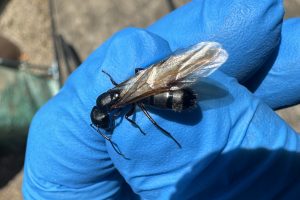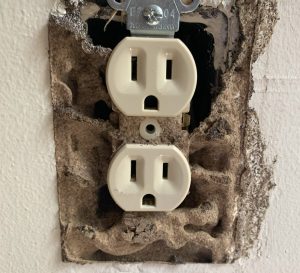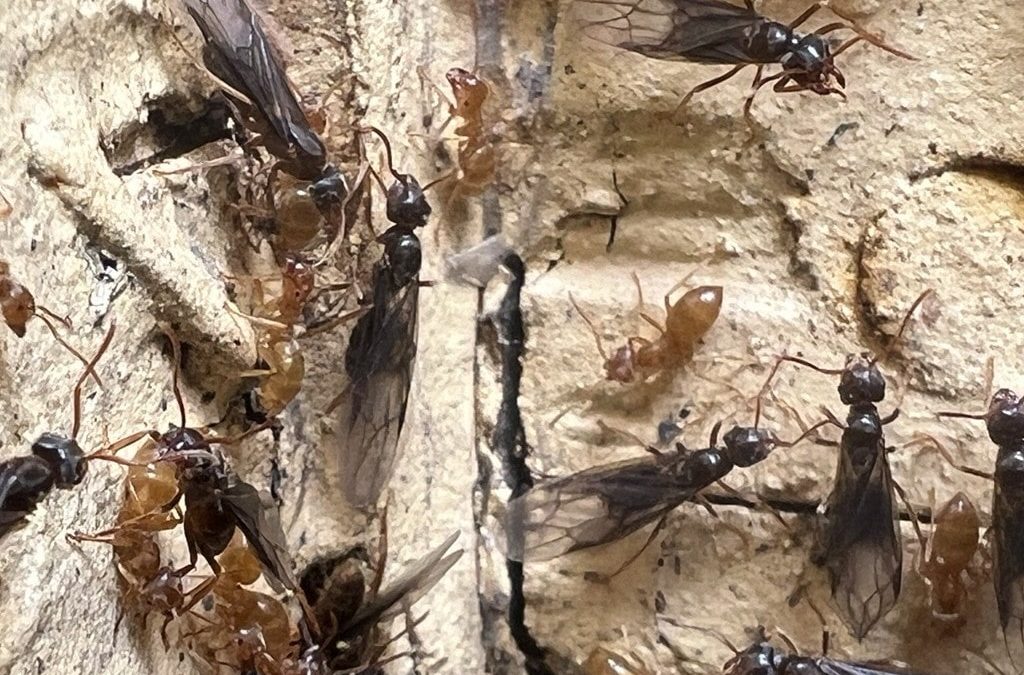Few things send a homeowner into a panic faster than the sight of flying insects pouring out of a wall, crawlspace, or windowsill. Most people’s first thought? “Oh no—termites!” But here’s the good news: in many cases, it’s not termites at all. It’s ants.
We get a lot of calls from folks who are convinced they’re seeing termites swarming—only to discover that it’s one of several ant species that send out winged reproductives this time of year. And while some ants (like carpenter ants) can still cause problems, most are more annoying than alarming.
Let’s walk through how to tell the difference between termite alates and the ants that are often mistaken for them—and while we’re at it, we’ll clear up one of the biggest termite myths: that you always need a pesticide treatment. (Spoiler: not if it’s a dampwood termite.)
Key Takeaways:
-
Many ant species send out winged reproductives that look a lot like termites—but there are key differences in body shape, antennae, and wings.
-
Carpenter ants are the most structurally significant ant species we see—most others are just a seasonal nuisance.
-
Dampwood termites don’t require chemical treatments—fixing moisture issues is the real solution.
-
Termite swarms usually follow specific conditions—if it doesn’t line up, it might just be ants.
“They’re Flying Out of My Wall—It Must Be Termites!”
That’s the thought that runs through just about everyone’s head when they see a swarm of winged insects indoors. But take a breath—odds are good they’re ants. Here’s how to tell.
First Things First: What Are Alates?
“Alate” is just the fancy word for a winged reproductive. In both ants and termites, the colony produces these winged adults when it’s time to start new colonies. When conditions are right—usually warm, humid weather—they’ll take flight in a mass event called a nuptial flight.
It’s dramatic, chaotic, and short-lived. Most of these alates won’t survive past the first 24 hours, but if they land in the right place, they’ll shed their wings, pair up, and try to start a new colony. Indoors, this whole process usually gets cut short by a vacuum cleaner and a phone call to us.
Seeing a few winged insects inside doesn’t always mean you’ve got a full-blown infestation—but it’s a strong sign there’s a nest somewhere nearby.
Termite Alates (Reproductives)
-
Body: Uniform width—no “waist” between thorax and abdomen
-
Wings: Two pairs, nearly equal in length, long and delicate
-
Antennae: Straight or slightly curved
-
Color: Dark brown to black (Western subterranean) or tan/red-brown (Dampwood)
-
Behavior: Swarm in large numbers, often indoors, usually after rain
Ant Alates (Reproductives)
-
Body: Pinched waist—three clear body segments
-
Wings: Front wings much longer than hind wings
-
Antennae: Bent or elbowed
-
Color: Varies by species—black, reddish, yellowish
-
Behavior: Often emerge from windowsills, wall voids, stumps, or cracks in concrete

A pest technician holds a winged queen ant—key evidence when identifying and treating ant infestations.
The Usual Ant Suspects
Carpenter Ants
-
Big and black (or red and black), these are the ones to watch.
-
Found in wall voids, moist wood, and attics.
-
If you’re seeing large winged ants indoors in spring, especially at night—they might be carpenter ants.
Velvety Tree Ants
-
Dark head and gaster, orange thorax—medium-sized.
-
Wood destroying ants, kinda like carpenter ants.
-
Usually swarm in late summer.
Odorous House Ants
-
Small, dark, and everywhere.
-
Swarm in spring or early summer.
-
If you crush them and smell something like rotten coconut, mystery solved.
Moisture Ants
-
Yellowish to light brown, small, and often found around rotting wood.
-
Nest in moist environments but don’t eat wood.
-
People often assume they’re dampwood termites—but they’re not.
Pavement Ants
-
Tiny and dark.
- Two nodes.
-
Swarm out of cracks in concrete, especially in slab-on-grade homes.
-
They’re aggressive but cant hurt you, and they don’t damage structures.

Subterranean termite mud tubes fill an open wall socket—an alarming sign of hidden structural infestation.
A Closer Look at the Real Termite Threats
Western Subterranean Termite
-
Small, dark-bodied alates with smoky gray wings.
-
Swarm in early spring, especially after rain.
-
Build colonies underground and enter homes through mud tubes.
-
Can cause serious structural damage if left unchecked.
Pacific Dampwood Termite
-
Big-bodied alates—reddish-brown with huge veined wings.
-
Swarm in late summer to early fall.
-
Nest directly in moist wood—don’t need contact with soil.
-
Don’t usually infest dry, sound wood—so they’re less likely to invade homes unless there’s a moisture problem.
Why Dampwood Termites Don’t Need Chemicals
One of the most common misconceptions we hear is that every termite sighting means a need for a chemical treatment. That’s true for subterranean termites—but not for dampwood termites.
Dampwoods don’t invade dry, healthy wood. They’re attracted to high-moisture, decaying wood. So if you’ve found them in or around your home, the solution isn’t just to treat—it’s to correct the conditions that brought them there.
Common Conditions That Attract Dampwood Termites:
-
Leaky outdoor faucets or hoses near siding or wood trim
-
Unvented crawlspaces with standing water or poor air circulation
-
Wood-to-soil contact (e.g. fence posts, deck supports) that stays wet
-
Wet bathroom subflooring from hidden plumbing leaks
-
Wood piles, roots, or stumps up against or under the foundation
Fixing these issues almost always resolves the problem. A good pest control plan might include monitoring or spot treatments, but without moisture, the colony can’t sustain itself.
Real Scenarios We See All the Time
-
A homeowner calls in a panic because “termite swarmers” came out of a basement window frame. We find it’s a seasonal carpenter ant swarm from a nest behind a slightly damp wall.
-
A client spots winged insects in the crawlspace during summer. It’s not subterranean termites—it’s moisture ants nesting in a soggy beam near a leaking HVAC drain.
-
Someone finds giant winged bugs outside near a woodpile and assumes the worst. It’s dampwood termites—but the woodpile is soaking wet and pressed right up against the siding.
Still Not Sure What You’re Dealing With?
You don’t have to guess. At Good Earth Pest Company, we’ve been sorting out winged insect mysteries for decades. Whether you’re dealing with carpenter ants, moisture ants, or a real termite issue, we can identify what you’re seeing and lay out a clear plan to solve it—no panic, no pressure.
If you’ve got questions, concerns, or just want peace of mind, give us a call. We’re here to help you figure it out.


